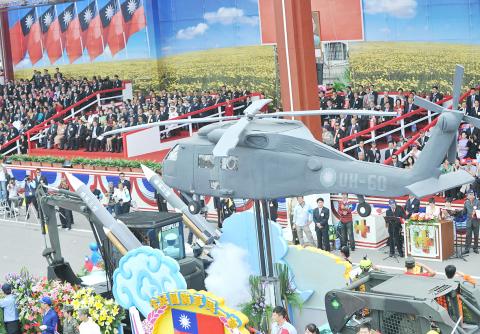Sikorsky Aircraft Corp was awarded a US$48.6 million firm-fixed-price contract for the procurement of four “green” UH-60M Black Hawk helicopters to Taiwan, the US Department of Defense announced last week.
Work will be performed at the Sikorsky plant in Stratford, Connecticut, with an estimated -completion date of May 30, 2013, said the release, issued on Thursday.
The four “green” helicopters — a term referring to initial assembly of a standard platform before customer add-ons are requested — are part of the 60 Black Hawk utility helicopters included in the US$6.4 billion Foreign Military Sale (FMS) notified to US Congress in January last year.

PHOTO: AFP
The estimated total cost for all 60 helicopters is US$3.1 billion.
The package includes a request for radar warning receivers, infrared countermeasure sets, missile-warning systems, laser-detecting sets, spare engines, machine gun systems, aviator night vision goggles and communication/data link systems for Taiwan’s “Po-Sheng” C4ISR (command, control, communications, computers, intelligence, surveillance and -reconnaissance) architecture.
Once integrated into the armed forces, the Black Hawks will replace its aging fleet of UH-1H Huey helicopters and serve a series of functions, including personnel movement, cargo lifting and medical evacuation, as well as defense of vital installations and close air support for ground forces.
The UH-60M is the US Army’s primary multi-mission helicopter.

ANOTHER EMERGES: The CWA yesterday said this year’s fourth storm of the typhoon season had formed in the South China Sea, but was not expected to affect Taiwan Tropical Storm Gaemi has intensified slightly as it heads toward Taiwan, where it is expected to affect the country in the coming days, the Central Weather Administration (CWA) said yesterday. As of 8am yesterday, the 120km-radius storm was 800km southeast of Oluanpi (鵝鑾鼻), Taiwan’s southernmost tip, moving at 9kph northwest, the agency said. A sea warning for Gaemi could be issued tonight at the earliest, it said, adding that the storm is projected to be closest to Taiwan on Wednesday or Thursday. Gaemi’s potential effect on Taiwan remains unclear, as that would depend on its direction, radius and intensity, forecasters said. Former Weather Forecast

As COVID-19 cases in Japan have been increasing for 10 consecutive weeks, people should get vaccinated before visiting the nation, the Centers for Disease Control (CDC) said. The centers reported 773 hospitalizations and 124 deaths related to COVID-19 in Taiwan last week. CDC Epidemic Intelligence Center Director Guo Hung-wei (郭宏偉) on Tuesday said the number of weekly COVID-19 cases reported in Japan has been increasing since mid-May and surpassed 55,000 cases from July 8 to July 14. The average number of COVID-19 patients at Japan’s healthcare facilities that week was also 1.39 times that of the week before and KP.3 is the dominant

The Chinese Communist Party’s (CCP) working group for Taiwan-related policies is likely to be upgraded to a committee-level body, a report commissioned by the Mainland Affairs Council (MAC) said. As Chinese President Xi Jinping (習近平) is increasingly likely to upgrade the CCP’s Central Leading Group for Taiwan Affairs, Taiwanese authorities should prepare by researching Xi and the CCP, the report said. At the third plenary session of the 20th Central Committee of the CCP, which ended on Thursday last week, the party set a target of 2029 for the completion of some tasks, meaning that Xi is likely preparing to

US-CHINA TRADE DISPUTE: Despite Beijing’s offer of preferential treatment, the lure of China has dimmed as Taiwanese and international investors move out Japan and the US have become the favored destinations for Taiwanese graduates as China’s attraction has waned over the years, the Ministry of Labor said. According to the ministry’s latest income and employment advisory published this month, 3,215 Taiwanese university graduates from the class of 2020 went to Japan, surpassing for the first time the 2,881 graduates who went to China. A total of 2,300 graduates from the class of 2021 went to the US, compared with the 2,262 who went to China, the document showed. The trend continued for the class of 2023, of whom 1,460 went to Japan, 1,334 went to